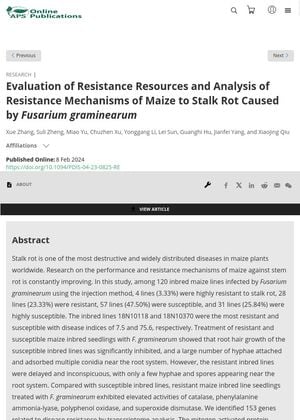Evaluation of Resistance Resources and Analysis of Resistance Mechanisms of Maize to Stalk Rot Caused by Fusarium Graminearum
July 2023
in “
Plant Disease
”

TLDR Some maize lines resist stalk rot better due to specific genes and enzyme activities.
This study evaluated the resistance of 120 inbred maize lines to stalk rot caused by Fusarium graminearum, finding that 4 lines (3.33%) were highly resistant, 28 lines (23.33%) were resistant, 57 lines (47.50%) were susceptible, and 31 lines (25.84%) were highly susceptible. Resistant lines showed delayed and minimal fungal growth near the roots, while susceptible lines had significant root hair inhibition and fungal attachment. Resistant lines also exhibited higher activities of catalase, phenylalanine ammonia-lyase, polyphenol oxidase, and superoxide dismutase. Transcriptome analysis identified 153 disease resistance-related genes, with the mitogen-activated protein kinase signaling and peroxisome pathways playing key roles in resistance mechanisms. Further study of these pathways could enhance understanding of molecular resistance and aid in resistance gene discovery.


